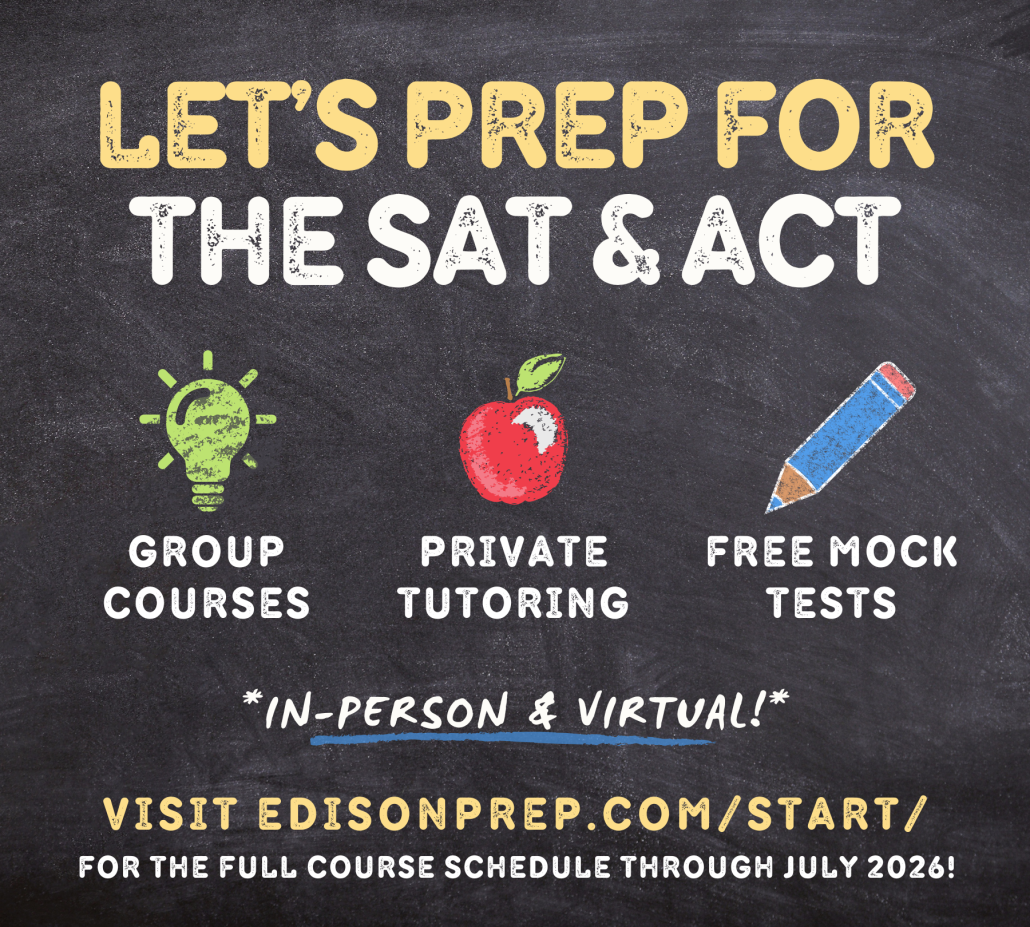Hot Off the Press—Tutor Insights from Taking the Real October 2025 ACT
By: Brian & Silvia Eufinger, Edison Prep Co-Founders
When we started Edison Prep in 2010, we made a commitment to staying up-to-date on the ACT and SAT’s changes over the years. The last few years in particular have seen dramatic changes in both exams, shifts in test prep, and shifts in the college admissions landscape overall. The SAT’s digital overhaul in 2024 was quickly followed by ACT’s shift to an ‘enhanced’ format, a test with fewer questions and, supposedly, more time per question.
To test drive the new exam format, we took the actual October ACT last weekend (yes, we’re allowed to—we’re honored to be one of the only two organizations in Georgia that is an ACT Affiliate, so we’re not only allowed to take the official test, we’re also allowed to use the 33 officially released tests with our students!). Keep reading to learn about our initial insights and strategies students should use going forward on this new exam.
English was the hardest to complete in time, and Math was the easiest—What in the world?
Back in 2020, we skipped the annual tradition of taking the June ACT (so a COVID senior could have our seats) and, instead, did a “speed run” via Facebook Live, completing the Math section in 28 minutes. Yet on this ACT, I used all the time afforded for all four sections. I felt all the stress, anger, confusion, and fear of not finishing the test in time—and we’ve been test prep educators for almost two decades.
Surprisingly, the English section—which is, historically, one of the more predictable sections and typically the only section students will finish in the time afforded—was one of the toughest sections to complete in time.
Why? The main differences between the Legacy ACT (pre-September 2025) and Enhanced ACT are fewer questions overall and an average of 19% more time per question. But because a disproportionate number of the easiest questions were removed in the transition, for 90% of students, the fast-paced nature of the ACT won’t feel much different—and results will likely turn out similarly. Because there are fewer questions overall, if you’re aiming for a tip-top score, there’s less room for error. Perfectionism and second-guessing could mean you spend too much time on any one question, sabotaging your chances at an elite score.
Another important change to note: Because the Science section is now optional, very few universities are requiring Science scores to be submitted. We will be repurposing the ~90 minutes spent on Science strategy in our group course, allowing us more time to cover the niche English concepts and high-level Math skills we saw on the October test. We still have an ‘ACT Science Module’ available for viewing on our Teachable video course that all students receive. Additionally, we will also be uploading a MyAnswerKey analysis of the October test once it is released!
We discuss the highlights of each section in more detail below, but ultimately, fewer questions on the enhanced ACT does not mean timing is no longer a challenge.
The ACT is still a fast-paced test, and students should be sure to complete all homework practice tests under strictly timed conditions.
Section Highlights:
1) English
- Having question ‘stems’ helped. Adding ‘Which of the following is most grammatically acceptable?’ and ‘Which of the following is least redundant in context?’ at the beginning of each question meant you did not have to determine what concept a question was testing; you simply had to answer the clearly stated question.
- Fewer questions directly testing punctuation like semicolons and colons
- The usual questions testing comma rules, avoiding excessive/unnecessary commas
- More questions testing word choice, reading comprehension, etc.
- Timing was tough. Although English is usually the fastest section, in the enhanced version, we were down to the wire.
We’ll be overhauling our English curriculum to reflect the significant shift in skills tested and proportion of questions of each type!
2) Math
- Questions didn’t increase in difficulty as linearly as they used to. A fair number of medium-level questions were in the final 10 problems, and some of the hardest problems were closer to the middle of the section. At the same time, the first 10-12 questions were pretty quick to complete.
- Many ‘classic’ (albeit challenging) topics were tested: Probability and expected value, imaginary numbers, sequences, rational and irrational numbers, and geometry formulas that were more common in 2014-2017 but not of late are back!
- Many topics felt new, unfamiliar, or are from tests long past: Finding inverse functions, the definition of similar triangles, dilation, exponential decay, lines of best fit, binomial expansion
- Plenty of questions could be fully solved using TI-84 calculator functions and apps like PlySmlt2 or Conics, or by graphing equations.
Surprisingly, Math was one of the easiest sections to complete in the time allotted—provided you leveraged your calculator knew your formulas! This is the opposite of the prior format Legacy exam.
3) Reading
- One passage included ‘Visual and Quantitative Information’ (VQI) questions, which require you to pull information from a graph, figure, or table.
- Fewer direct ‘line reference’ questions that told you exactly which lines to look at meant it was necessary to more closely read the text, making students still fully use the 27% more time per question that the Enhanced format allows.
- Passages felt more abstract, and less direct.
- In the paired passage, questions were not labeled with the familiar boxes indicating ‘Passage A’ or ‘Passage B’ (you could tell based on the question). There were also more questions comparing the two passages than on previous tests.
4) Science
- Many questions were simple ‘point-and-click’ tasks requiring you to find a particular entry, variable, or value in a chart or graph.
- About 2-3 questions required outside science knowledge, consistent with the Legacy ACT.
- Even with 5 additional minutes (compared to the Legacy ACT), timing was tough and many students in the room finished right as time was called.
Composite Scores
With the Science section now optional, students’ composite scores are now calculated as the average of their English, Math, and Reading scores: the so-called “Core Composite” or “EMR Composite.” Moving from the average of three section scores to the average of four section scores means higher variability in composite scores, especially for high-scorers. And where a score of 26.5 used to be rounded to a 27, now, a 26.33 doesn’t cut it: students need one more point to get that 26.67 to round up!
The “ACT cushion at the top” remains a beautiful thing. On the inaugural enhanced ACT in September 2025, you could miss as many as 22 questions out of the 131 across English, Math, and Reading, and still get a composite score of 30—a top 7% score! Missing 37 questions still resulted in a composite score of 25 (top 20%) that would qualify a student for the Zell Miler 100% HOPE Scholarship. And just because people wonder, yes, you could still miss as many as 6 questions and get a 35.67, which rounds to a perfect 36! This “cushion at the top” remains one main advantage ACT had on the Legacy exam and retains on the Enhanced exam. Missing 22 questions (or even 10!) on the SAT would have a much more dramatic downward impact.
SAT & ACT Score Concordance
In our opinion, SAT/ACT score concordance has diverged in recent years at the very top end of the scale. Prior to the debut of the digital SAT, SAT/ACT score concordance tables (tools that show how scores from different tests compare) were relatively accurate. But when the SAT shrank from 154 to 90 questions, the now-retired Legacy ACT’s scales felt more generous, and SAT less forgiving, especially for top scorers.
But after taking the October ACT, it feels like the new Enhanced ACT’s score scale has been brought back into closer alignment with the SAT. For both tests, adjusting score distributions after a major change isn’t new; before the College Board overhauled the SAT in 2015, the SAT Math section had drifted to be so easy that missing just one Math question sometimes meant your score dropped by 40 points. That was fixed in the transition!
Who should take the ACT?
The best way to determine whether you should pursue the ACT or SAT is to take a full-length mock test of each (prior to significant study) and compare your scores.
Edison Prep holds free diagnostic tests every weekend—you can RSVP here! Our test prep pros work with every student to craft a customized prep plan based on their stronger test and their colleges of potential interest!
You can also take a mock elsewhere as long as it is a real test. Many large companies use their own in-house tests that are wildly inaccurate, so please verify via email or phone what the test form code is of any third party test you may be offered.
Questions? Thoughts? Want to share what your student thought of the Sept. or Oct. Enhanced ACT?
Reach out at edison@edisonprep.com or 404-333-8573!









